Description
Astronomy and Astrology in al-Andalus and the Maghrib
Variorum Collected Studies Series
Author: Samsó Julio
Language: English
Subject for Astronomy and Astrology in al-Andalus and the Maghrib:
Approximative price 58.78 €
In Print (Delivery period: 14 days).
Add to cart
Astronomy and Astrology in al-Andalus and the Maghrib
Publication date: 01-2019
· 15x22.4 cm · Paperback
Publication date: 01-2019
· 15x22.4 cm · Paperback
Approximative price 192.54 €
Subject to availability at the publisher.
Add to cart
Astronomy and astrology in Al-Andalus and the Maghrib
Publication date: 10-2007
380 p. · 15.2x22.9 cm · Hardback
Publication date: 10-2007
380 p. · 15.2x22.9 cm · Hardback
Description
/li>Contents
/li>Biography
/li>
This new volume of papers by Julio Samsó deals with the development of astronomy and astrology in al-Andalus and the Maghrib between the 10th and the 19th centuries. Opening with a survey of the social history of the exact sciences in al-Andalus, the book then looks at astronomical tables: the first stages of the introduction of al-Khwarizmi's and al-Battani's tables through the school of Maslama al-Majriti, the development of Ibn al-Zarqalluh/ Azarquiel's theories in Maghribi zijes (Ibn al-Banna' and Ibn Azzuz) and the abandonment of this tradition towards the end of the 14th century. From this period onwards new Eastern zijes (Muhyi al-Din al-Maghribi, Ibn al-Shatir, Ulugh Beg) are introduced in the Maghrib and, towards the beginning of the 17th century, a translation of Abraham Zacut and José Vizinho's Almanach Perpetuum (end of the 15th century) becomes well known in the whole Islamic world, from Morocco to the Yemen. As well as zijes themselves, the author also deals with theoretical astronomy (the use of an elliptical deferent for Mercury in Ibn al-Zarqalluh's equatorium and the criticisms of Ibn al-Haytham and Jabir b. Aflah on Ptolemy's determination of the parameters of the same planet), and with the use of zijes for the calculation of horoscopes, and an experimental astrological method for the correction of mean motion planetary tables (Ibn Azzuz).
Contents: Preface. Part 1 Al-Andalus: A social approximation to the history of the exact sciences in al-Andalus; Maslama al-Majriti and the star table in the treatise De mensura astrolabii; 7 chapters of Ibn al-Saffar's lost zij (with M. Castells); Ibn al-Zarqalluh on Mercury (with H. Mielgo); World astrology in 11th-century al-Andalus: the epistle on tasyir and the projection of rays by al-Istijji (with H.Berrani); 'Al-Biruni' in al-Andalus; Ibn al-Haytham and Jabir b. Aflah's criticism of Ptolemy's determination of the parameters of Mercury. Part 2 The Maghrib: The computation of planetary longitudes in the zij of Ibn al-Banna (with E. Millás); Andalusian astronomy in 14th-century Fez: al-Zij al-Muwafiq of Ibn Azzuz al-Qusantini; Horoscopes and history: Ibn Azzuz and his retrospective horoscopes related to the battle of El Salado (1340); An outline of the history of Maghribi zijes from the end of the 13th century; Astronomical observations in the Maghrib in the 14th and 15th centuries; On the lunar tables in Sanjaq Dar's Zij al-Sharif. Part 3 The Introduction of Alfonsine Astronomy in the Arab World through the Arabic Translations of Zacut's Almanach Perpetuum: Abraham Zacut and José Vizinho's Almanach Perpetuum in Arabic (16th-19th centuries); On the Arabic translation of the colophon of the Almanach Perpetuum; In pursuit of Zacut's Almanach Perpetuum in the eastern Islamic world; Addenda et corrigenda; Indexes.
Julio Samsó is Professor in the Department of Arabic, University of Barcelona, Spain.
© 2024 LAVOISIER S.A.S.




